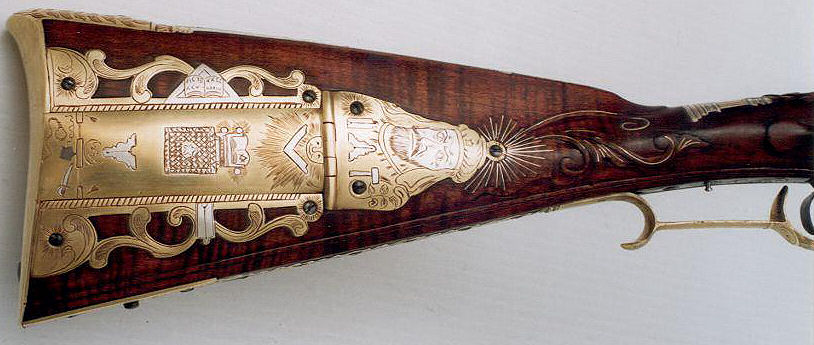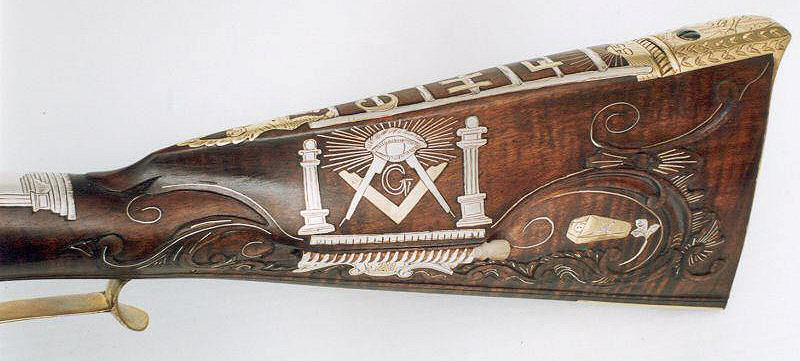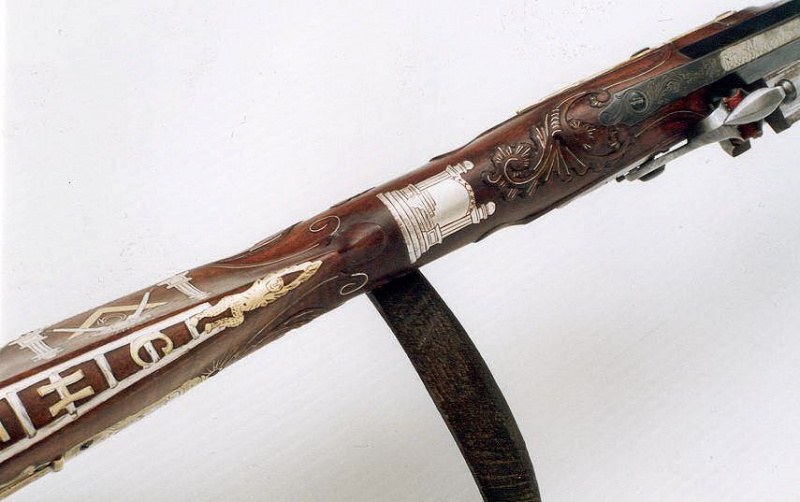En: Early Masonic Inlaid Rifle: Unterschied zwischen den Versionen
(Die Seite wurde neu angelegt: „ == Early Masonic Inlaid Rifle == Source: Phoenixmasonry From the condition of this Masonic rifle/musket we believe that it is recently manufactured to …“) |
Keine Bearbeitungszusammenfassung |
||
| (5 dazwischenliegende Versionen von 2 Benutzern werden nicht angezeigt) | |||
| Zeile 4: | Zeile 4: | ||
Source: [[Phoenixmasonry]] | Source: [[Phoenixmasonry]] | ||
[[Datei:Rifle butt 2.jpg]] | |||
From the condition of this Masonic rifle/musket we believe that it is recently manufactured to make it look old. The workmanship is incredibly well done with the silver inlays of the Square and Compasses with the Letter "G" and the All-Seeing Eye between the Pillars of Boaz and Jachin; Jacob's Ladder with the three rungs representing Faith, Hope and Charity; the coffin with the sprig of acacia and the various other working tools! Although it might not be old now it is certainly destined to be a Masonic artifact someday! | From the condition of this Masonic rifle/musket we believe that it is recently manufactured to make it look old. The workmanship is incredibly well done with the silver inlays of the Square and Compasses with the Letter "G" and the All-Seeing Eye between the Pillars of Boaz and Jachin; Jacob's Ladder with the three rungs representing Faith, Hope and Charity; the coffin with the sprig of acacia and the various other working tools! Although it might not be old now it is certainly destined to be a Masonic artifact someday! | ||
| Zeile 9: | Zeile 11: | ||
[[Datei:Rifle butt 1.jpg]] | [[Datei:Rifle butt 1.jpg]] | ||
[[Datei:Rifle butt 3.jpg|thumb|800px|center]] | |||
== David Abraham Ragains == | |||
[[Datei:Ragains masonic rifle 6.jpg|thumb|800px|center]] | |||
There is little doubt that David Abraham Ragains acquired his "Masonic" rifle before the Civil War. David joined the 60th Illinois Infantry Regiment on January 7, 1862 as a private in the Union Army. The following month, he was promoted to Captain in command of Company H. | |||
It is unlikely that Captain Ragains carried this rifle with him when the 60th Illinois Infantry Regiment entered the war. The 60th Illinois Infantry Regiment joined forces with the U.S Army of the Mississippi in capturing the strategically important Island Number Ten, on the Mississippi River. After the capture of this island, David participated in the siege of Corinth and led his Company in several clashes with the enemy. Unfortunately by February of 1863, the 50 year old Captain was forced to resign his commission because of poor health. Hemorrhoids, caused by dysentery, had become so painful that he could no longer perform his duties. | |||
[[Datei:Ragains masonic rifle 2.jpg]] | |||
Patriotism and personal sacrifice were deeply engrained in David's soul. Two of David's grandfathers, Thomas Ragains and William Hargiss, and one of his great-grandfathers, James Jay, were Patriots in the Revolutionary War. Another of his great-grandfathers, Gabriel Ragains, served as a Gentleman Soldier, under George Washington, during the French and Indian war. Gabriel was killed by" friendly fire", when two scouting parties mistook the other for the enemy. David's 5th great-grandfather, Robert Bartlett was one of five Pilgrims killed by the Indians during the hostilities known as "King Phillip's" war. David's 6th great-grandfather was a passenger on the "Mayflower". | |||
[[Datei:Ragains masonic rifle 1.jpg]] | |||
David was born in South Carolina, lived in Tennessee, Kentucky and Georgia before settling in Pope County, Illinois. At the beginning of the Civil war David was supporting a family of eight children by working his small farm. He supplemented his income as both deputy clerk and deputy sheriff. While serving his community as a clergyman, he founded County Line Baptist Church. This church came by its name because it was located on the Pope and Johnson County Line. This little church is still going strong after 150 years. During his lifetime, David had seven wives and twenty children. He died on February 17, 1887 at age 74. He was a member of the Vienna, Illinois Lodge No 150 A.F. and A.M. | |||
David left his rifle to his son, Pleasant Green Ragains. The next owner was P. G.'s son, Frank Ragains who was a member of the Bokoshe, Oklahoma Lodge No. 358 and Murrow Lodge No. 49 in Spiro, Oklahoma. The next owner was his son, Frank Edward Ragains The gun then went to his son, James Edward Ragains and then to his son, James Grant Ragains. David Ragains' gun has been in the Ragains' family for over 150 years. | |||
Charles Edward Sterling | |||
February 5, 2009 | |||
== Abraham Lincoln == | |||
On the 7th of April 1862, David Ragains answered [[Abraham Lincoln]]'s call to arms by joining Company H, 60th Illinois Regiment as a private. In recognition of his maturity and ability to lead men, he was promoted to Captain and placed in charge of a newly formed company. Despite the fact that he was almost fifty, David felt compelled to join the struggle to preserve the Union. David's loyalty and enthusiastic patriotism can be traced to his grandfather Thomas Ragains' and his great grandfather, Gabriel Ragains' records of military service. | |||
Gabriel was a "Gentleman Solger" on call to the North Carolina Militia. When the French and Indian War erupted, Gabriel's unit was activated and made part of the Virginia Regiment under Colonel George Washington. Gabriel's service ended abruptly when he was killed by friendly fire near Fort Ligonier in western Pennsylvania. Gabriel was survived by his wife, Susannah Gandy and his five year old son, Thomas. | |||
When Thomas was twenty-three years old, he married thirteen year old Elizabeth Featherkille on Valentines Day in 1776. Thomas and Elizabeth enjoyed a short honeymoon before he marched off to war. Thomas survived the war suffering only a minor leg wound. He served one year as a private and another two years as a sergeant. During his three years of service, he managed to obtain enough furloughs to father two sons. After the war he and Elizabeth went on to have six more sons and three daughters. | |||
It is likely that David grew up listening to his grandfather, Thomas, recalling his military experiences. Thomas probably told of his father Gabriel's military valor also. David Ragains was twenty-three when his grandfather, Thomas, died. | |||
'''The following quote was written by Grant Ragains who is the grandson of Capt. David Abraham Ragains,''' | |||
“The gun (cap and ball) was made in a country shop by J. Belleau, a gun & locksmith and a master mason. He was evidently a modern tubal cane. This word has no meaning to you but it means a lot to me. A mason could give a chart lecture off it. It was made for my Grandpa Ragains (David Abraham) then passed to my father (Pleasant Green) and I want it to pass to James’ son (James Grant Ragains who I received it from). I would like for him to someday learn the meaning of all those emblems. The stock of this gun is made of wild cherry by a wonderful workman. I have taken this gun to several Masonic lodges and it was considered the wonder of the ages. Grandpa Ragains was both a master mason and a royal arch mason and naturally praised the gun very highly.” | |||
{{SORTIERUNG:Earlymasonic}} | |||
[[Kategorie:English]] | |||
Aktuelle Version vom 13. Juni 2015, 21:14 Uhr
Early Masonic Inlaid Rifle
Source: Phoenixmasonry
From the condition of this Masonic rifle/musket we believe that it is recently manufactured to make it look old. The workmanship is incredibly well done with the silver inlays of the Square and Compasses with the Letter "G" and the All-Seeing Eye between the Pillars of Boaz and Jachin; Jacob's Ladder with the three rungs representing Faith, Hope and Charity; the coffin with the sprig of acacia and the various other working tools! Although it might not be old now it is certainly destined to be a Masonic artifact someday!
David Abraham Ragains
There is little doubt that David Abraham Ragains acquired his "Masonic" rifle before the Civil War. David joined the 60th Illinois Infantry Regiment on January 7, 1862 as a private in the Union Army. The following month, he was promoted to Captain in command of Company H. It is unlikely that Captain Ragains carried this rifle with him when the 60th Illinois Infantry Regiment entered the war. The 60th Illinois Infantry Regiment joined forces with the U.S Army of the Mississippi in capturing the strategically important Island Number Ten, on the Mississippi River. After the capture of this island, David participated in the siege of Corinth and led his Company in several clashes with the enemy. Unfortunately by February of 1863, the 50 year old Captain was forced to resign his commission because of poor health. Hemorrhoids, caused by dysentery, had become so painful that he could no longer perform his duties.
Patriotism and personal sacrifice were deeply engrained in David's soul. Two of David's grandfathers, Thomas Ragains and William Hargiss, and one of his great-grandfathers, James Jay, were Patriots in the Revolutionary War. Another of his great-grandfathers, Gabriel Ragains, served as a Gentleman Soldier, under George Washington, during the French and Indian war. Gabriel was killed by" friendly fire", when two scouting parties mistook the other for the enemy. David's 5th great-grandfather, Robert Bartlett was one of five Pilgrims killed by the Indians during the hostilities known as "King Phillip's" war. David's 6th great-grandfather was a passenger on the "Mayflower".
David was born in South Carolina, lived in Tennessee, Kentucky and Georgia before settling in Pope County, Illinois. At the beginning of the Civil war David was supporting a family of eight children by working his small farm. He supplemented his income as both deputy clerk and deputy sheriff. While serving his community as a clergyman, he founded County Line Baptist Church. This church came by its name because it was located on the Pope and Johnson County Line. This little church is still going strong after 150 years. During his lifetime, David had seven wives and twenty children. He died on February 17, 1887 at age 74. He was a member of the Vienna, Illinois Lodge No 150 A.F. and A.M.
David left his rifle to his son, Pleasant Green Ragains. The next owner was P. G.'s son, Frank Ragains who was a member of the Bokoshe, Oklahoma Lodge No. 358 and Murrow Lodge No. 49 in Spiro, Oklahoma. The next owner was his son, Frank Edward Ragains The gun then went to his son, James Edward Ragains and then to his son, James Grant Ragains. David Ragains' gun has been in the Ragains' family for over 150 years.
Charles Edward Sterling
February 5, 2009
Abraham Lincoln
On the 7th of April 1862, David Ragains answered Abraham Lincoln's call to arms by joining Company H, 60th Illinois Regiment as a private. In recognition of his maturity and ability to lead men, he was promoted to Captain and placed in charge of a newly formed company. Despite the fact that he was almost fifty, David felt compelled to join the struggle to preserve the Union. David's loyalty and enthusiastic patriotism can be traced to his grandfather Thomas Ragains' and his great grandfather, Gabriel Ragains' records of military service.
Gabriel was a "Gentleman Solger" on call to the North Carolina Militia. When the French and Indian War erupted, Gabriel's unit was activated and made part of the Virginia Regiment under Colonel George Washington. Gabriel's service ended abruptly when he was killed by friendly fire near Fort Ligonier in western Pennsylvania. Gabriel was survived by his wife, Susannah Gandy and his five year old son, Thomas.
When Thomas was twenty-three years old, he married thirteen year old Elizabeth Featherkille on Valentines Day in 1776. Thomas and Elizabeth enjoyed a short honeymoon before he marched off to war. Thomas survived the war suffering only a minor leg wound. He served one year as a private and another two years as a sergeant. During his three years of service, he managed to obtain enough furloughs to father two sons. After the war he and Elizabeth went on to have six more sons and three daughters.
It is likely that David grew up listening to his grandfather, Thomas, recalling his military experiences. Thomas probably told of his father Gabriel's military valor also. David Ragains was twenty-three when his grandfather, Thomas, died.
The following quote was written by Grant Ragains who is the grandson of Capt. David Abraham Ragains,
“The gun (cap and ball) was made in a country shop by J. Belleau, a gun & locksmith and a master mason. He was evidently a modern tubal cane. This word has no meaning to you but it means a lot to me. A mason could give a chart lecture off it. It was made for my Grandpa Ragains (David Abraham) then passed to my father (Pleasant Green) and I want it to pass to James’ son (James Grant Ragains who I received it from). I would like for him to someday learn the meaning of all those emblems. The stock of this gun is made of wild cherry by a wonderful workman. I have taken this gun to several Masonic lodges and it was considered the wonder of the ages. Grandpa Ragains was both a master mason and a royal arch mason and naturally praised the gun very highly.”






